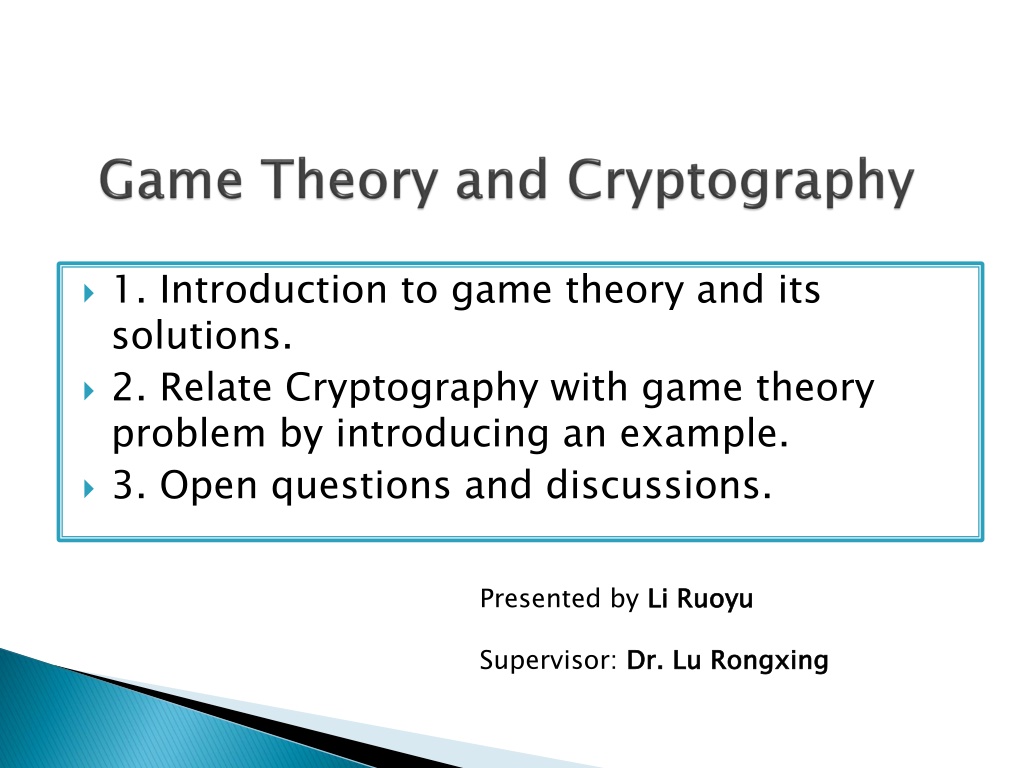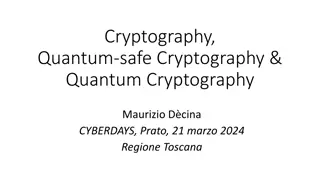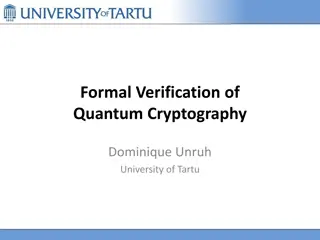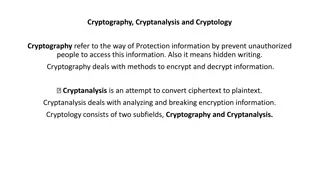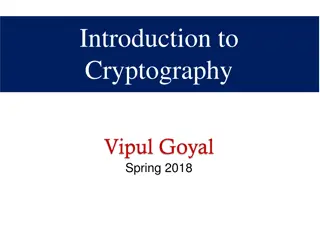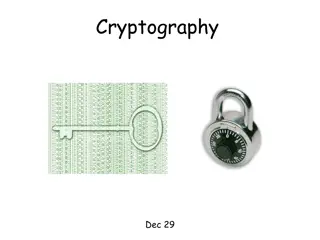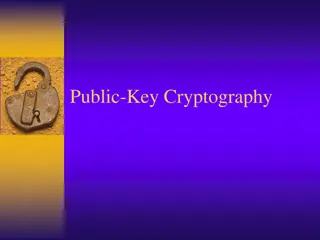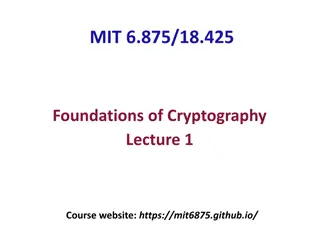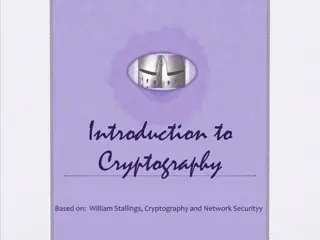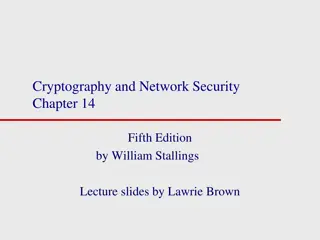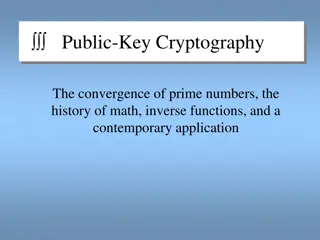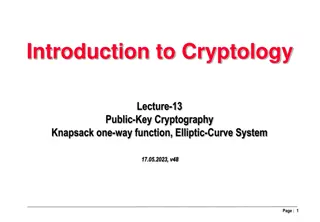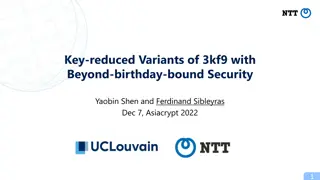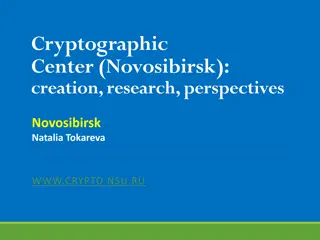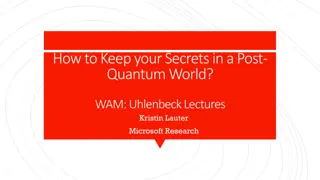Game Theory and Its Application in Cryptography
Game theory involves analyzing conflicts and cooperation among decision-makers, providing mathematical models for decision-making. By relating cryptography to game theory, we can see how rational agents make choices to maximize utility. The example of the Prisoner's Dilemma highlights strategic decision-making in a one-shot game scenario. Understanding the players, actions, and payoff matrices is crucial in analyzing various strategic interactions.
Download Presentation

Please find below an Image/Link to download the presentation.
The content on the website is provided AS IS for your information and personal use only. It may not be sold, licensed, or shared on other websites without obtaining consent from the author.If you encounter any issues during the download, it is possible that the publisher has removed the file from their server.
You are allowed to download the files provided on this website for personal or commercial use, subject to the condition that they are used lawfully. All files are the property of their respective owners.
The content on the website is provided AS IS for your information and personal use only. It may not be sold, licensed, or shared on other websites without obtaining consent from the author.
E N D
Presentation Transcript
1. Introduction to game theory and its solutions. 2. Relate Cryptography with game theory problem by introducing an example. 3. Open questions and discussions. Presented by Li Li Ruoyu Ruoyu Supervisor: Dr. Lu Dr. Lu Rongxing Rongxing
Game theory can be defined as the study of mathematical models of conflict and cooperation between intelligent rational decision Game theory provides general mathematical techniques for analyzing situations in which two or more will influence one another s welfare B. Myerson, 1991] decision- -maker makers. two or more individuals make decisions that influence one another s welfare. [Roger
Utility Theory can be used to measure relative preference of an agent. Utility function: a mapping from a state of the world to a real number, indicating the agent s level of happiness with each state of the world. Used in computing investment preference and Artificial Intelligence in various decisions to be made in learning, classification tasks, etc. The Maximum Expected Utility Principle
A rational agent should choose the action that maximizes the agent s expected utility. ,where e is a set of evidences. action = max ??(?/?) ?
1. Two accomplice caught by the Police 2. Interrogated separately 3. The police suggests a deal 4. Choices of the prisoner: Cooperate the other prisoner]. In other words, do not confess police]. Cooperate or Defect Defect [to do not confess [to the confess or confess
PD is One shot game- only played once Simultaneous move game- when playing, agents do not knowother player s choice. Otherwise, sequential move game PD is a non players interests are not always in direct conflict both to gain their utilities. non- -zero/non zero/non- -constant sum constant sum game: direct conflict, so that there are opportunities for
The players How many players are there? Anyway, N>1 A complete description of the actions available to each player- identical or may not all players actions form a strategy profile A description of consequences (payoff) for each player for every possible combination of actions (strategy profiles)- payoff matrices
Prisoner 2 Prisoner 2 Cooperate Cooperate Defect Defect CooperateR/R (3/3) S/T (0/5) Prisoner 1 Prisoner 1 Defect T/S (5/0) P/P (1/1) Note: T > R > P > S and 2R > T + S.
What if we let the game repeat ? What if the game repeats for unbounded time of round ? Will the agents try other actions instead of D (defect) ?
Definition of Best Response Definition of Best Response:
Definition 1.1 Nash Equilibrium Definition 1.1 Nash Equilibrium Definition 1.2 (Strict Nash equilibrium) Definition 1.2 (Strict Nash equilibrium) Definition 1.3 (Weak Nash equilibrium) Definition 1.3 (Weak Nash equilibrium)
Play Prescription Given NE s*, s* is a prescription to play. No one player has incentive to deviate from it s play in s* because unilaterally doing so will lower its payoff. Pre-play Communication Players meet beforehand and discuss and reach to an agreement on how to play the game. It is not understandable that players would come to an agreement that is not an NE. (rational players) Rational Introspection Players will ask themselves what would be the outcome of the game. Assuming non of the agents will make a mistake, try to introspect rational decisions for all including itself.
No regrets concept Having all other agents choices fixed, did I do the best I can do? Self-fulfilling belief I believe everyone else will do what s the best for itself, I will do my best. Trial and Error Players start playing a strategy profile that is not a NE. Some players discover they are not playing their best, so improve the payoff by switching from one action to another. This goes on until a strategy profile that is a NE is found. (No guarantee this will happen. But many repeated game or evolutionary game theory are interested in this)
NE is the solution to a game Usually for a given game with NE existing, there are more than one strategy NE, some are pure. Some are strict but most are weak NE. Does NE always exist ? Not always more than one NE, some are mixed Not always.
1. Pure Strategy NE Recall PD game for practice. Cooperate Cooperate Defect Defect CooperateR/R (3/3) S/T (0/5) Defect T/S (5/0) P/P (1/1)
2. Mixed Strategy NE Step1: For Player A, if it has actions ?1,?2, ..??,We assign probabilities ?1,?2, ??to represent corresponding actions likelihood of being selected. Step2: Calculate the expected payoff F(??) of Player B if B plays Action ?? based on the assumption that A plays strategy P={?1,?2, ??} on the action pool {?1,?2, ..??}. Step3: Let all expected payoffs of B under ??,?=1,2,3 .. identical and then we obtain the probability distribution on actions of A.
Example: battle of sex Husband s strategy: ?, football; 1 ?, opera Wife s expected payoff if she chooses football :? 1 + 1 ? 0 = ?. If wife chooses opera :? 0 + 1 ? 3 = 3 3?. Football Football Opera Opera Football(3/1) (0/0) Opera (0/0) (1/3) if we let two payoffs equal, it turns out that ? =3 4, then 1 ? =1 4
Q: Why we set the payoffs of wife equal under different selection of action? A: by doing that, no matter what distribution over wife s actions, husband s strategy (3 is always the best response to wife s strategy. Similarly, we obtain further that wife s mixed strategy to guarantee her strategy a B.R. is (1 Mixed Strategy NE is H: (3 4, 1 4) 4,3 4) over {football, opera}. 4, 1 4) ; W: (1 4,3 4) .
Note: 1. In the solution concept, elimination of dominated strategies, we claimed that a rational player will never play a dominated strategy. 2. This definition allows a player to believe that the other players actions are correlated.
In some games, the assumption of rationality significantly restricts the player s choice. For any belief about the other player s action (i.e., no matter what the other chooses), D yields higher payoff. C D C (3/3) (0/5) D is therefore only rational choice. Strategy C isn t rationalizable for row player C isn t a best response to any strategy that column player could play D (5/0) (1/1) any
In some other games, the assumption of rationality is less restrictive. If 1 believes that 2 will choose C, then 1 will choose C as well. 2 C D If 1 believe that 2 will choose D, then 1 will choose D. C 3/2 0/3 1 Thus, both C and D are rational choices for 1. D 2/0 1/1 But for 2, only D is rational choice.
Two pure strategy NE C C D D (D C) and (C D) C 6, 6 2, 7 The average payoff (7+2)/2=4.5 One mixed strategy NE D 7, 2 0, 0 C: 2/3 D: 1/3 Expected payoff of the two agents : 14/3 = 4.66667
From above game, we observe that if player 1 choose D, player 2 has no incentive to choose D since the corresponding payoffs (0,0) are both dominated by other options. While, in mixed NE, it still has probability 1/3*1/3 = 1/9 to choose the action profile (D,D). It is obvious not reasonable.
In a standard game, each player mixes his pure strategies independently In this sense, the correlated equilibrium solution concept generalizing the Nash equilibrium. In correlated equilibria, agents mix their strategy correlatively. Instead of studying distribution over player s actions, CE studies the distribution over action profiles. correlated equilibrium is a
Eliminating (D,D), the rest of action profiles (C,D),(D,C) and (C,C) are picked randomly. A random device (or random variable) with known distribution determines two players action through a private signal to each player. C C D D C 6, 6 2, 7 D 7, 2 0, 0
The random device can work according to any distribution. We assume it runs as (1/3,1/3,1/3) over the three action profiles. Expected payoffs of the two: 1/3*7 + 2/3*1/2*6 + 2/3*1/2*2 = 5 5>4.666. CE gives higher payoff than NE Different from NE, in CE player could inference partially about what other player is going to play.
Look for Best distribution over strategy files Look for Best distribution over strategy files
If player i receives a suggested strategy ??, the expected payoff of the player cannot be increased by switching to a different strategy ? . Nash Equilibria are special cases of correlated equilibria, where the distribution over strategy profile S is the product of independent distributions over each player s actions. Uniform distribution over S is always a CE Every NE could form a CE, but not every CE is equivalent to a NE. CE is a more general concept.
In order to implement CE, a trusted third party (mediator) should be postulated. It chooses the pair of actions (??,??) for both players according to the right joint distribution over S and privately tells two sides its action. Since the strategy is correlated, it is often that one s action carries some information about other s move. But it won t agitate players to deviate from suggested moves.
Is it possible? Replace the mediator with a secure two party cryptographic protocol and let it play the role of random device for profile selection ? Dodis, Yevgeniy, Shai Halevi, and Tal Rabin. "A cryptographic solution to a game theoretic problem." Advances in Cryptology CRYPTO 2000. Springer Berlin Heidelberg, 2000. Cited over 100 times since 2000.
To remove the mediator, we assume the players are (1)computational bounded (2) communicate prior to playing the game. The function of mediator is modeled as a correlated element selection procedure: A, B + (?1,?1), (?2, ?2) .(??, ??). It needs A,B jointly let B play ??. jointly choose a index ? and then let A play ??,
A public key encryption is blindable if there exist a P.P.T. algorithm blind and combine such that for every message m and every ciphertext c ?????(?) ?????? + ? ???????(?,? ) without m and sk If ?1and ?2are random coins used by two successive blindings , then for any two blinding factors ?1, ?2, ???????(????????,?1;?1,?2;?2) =???????(?,?1+ ?2; ?????????(?1,?2)) ElGamal, Goldwasser-Micali encryption scheme can be extended to blindable encryption
? Common inputs: List of pairs (??,??)?=1 , public key pk. Preparer knows: secret key sk. P : 1. Permute and Encrypt Pick a random permutation over [n ]. Let (ci, di ) = (Encpk(a (i )), Encpk(b (i ))), for all i [n ]. Send the list (??,??)?=1 C : 2. Choose and Blind Pick a random index ? [n ], and a random blinding factor . Let (e, f ) = (Blindpk(??, 0), Blindpk(??, )). Send (e, f ) to P. P : 3. Decrypt and Output Set a = Decsk(e ), ? = Decsk(f ). Output a. Send ? to C. C : 4. Set b = ? . Output b. 1. Permute and Encrypt. ?to C. 2. Choose and Blind. 3. Decrypt and Output. 4. Unblind Unblind and Output and Output.
If both sides follow the protocol, their outputs are indeed random pair (??,??) from the know list (??,??)?=1 The protocol securely resolves the correlation selection problem and leaks no more information other than output itself. If distribution over strategy profiles is not uniform, the list could be modified by adding more repetitions for those profiles with high probability. ?.
Dishonest Players may deviate from the suggested moves/ give wrong encryption Add a zero-knowledge proof after each flow of the protocol to let players prove that they do follow the prescribed protocol.
?, public key pk. Common inputs: List of pairs (??,??)?=1 Preparer knows: secret key sk. P : 1. Permute and Encrypt Pick a random permutation over [n], and random strings (??,??)?=1 Let (ci, di) = (Encpk(a (i); r (i)), Encpk(b (i); s (i))), for all i [n]. Send (??,??)?=1 Sub randomness (??,??)?=1 (??,??)?=1 C : 2. Choose and Blind Pick a random index ? [n]. Send to P the ciphertext e = Blindpk(??, 0). Sub knows the randomness and index ? that were used to obtain e. P : 3. Decrypt and Output Set a = Decsk (e ). Output a. Send to C the list of pairs (b (i ),s (i ))?=1 C : 4. Verify and Output Denote by (b, s) the ? th entry in this lists (i.e., (b, s) = (b (?), s (?)) ). If ?? = Encpk(b; s) then output b. 1. Permute and Encrypt. ?. ? to C. Sub- -protocol protocol _1: P proves in zero-knowledge that it knows the ? and permutation that were used to obtain the ?. 2. Choose and Blind. Sub- -protocol protocol _2: C proves in a witness-independent manner that it 3. Decrypt and Output. ? (in this order). 4. Verify and Output.
For the second proof of knowledge, it is not necessary to be zero knowledge, a weak condition - witness independent proof -is good enough. Only one decryption, bring high efficiency if decryption is more difficult.
By implementing the cryptographic solution to the game theoretic problem, we gain on the game theory front, it turns out that the mediator could be eliminated. In cryptographic front, we also gain by excluding the problem of early stopping. In some situation, game theoretic setting may punish the malicious behaviors and increase the security. Maybe it is no need to add zero- knowledge-proof into the protocol.
